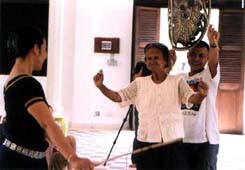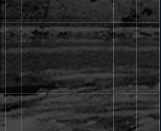|
Obviously,
the singling out of one group is no more defensible than of another,
but why the vendetta against the artists, most particularly the
dancers? When he saw their predecessors perform in Paris in 1908,
the sculptor Rodin wrote, "It is impossible to see human nature
brought to a higher state of perfection…We have only them and
the Greeks…" Ironically, the European adoration of Cambodian
culture played some role in Pol Pot’s death sentence. During
their rule from the mid-19th century to 1940, the French contributed
considerably toward preserving lakon krabach boran, as the
"dance of the palace ladies" is called, although they
separated it from royal control, cultivated it in the salons of
colonial aficionados, and allowed foreign elements to permeate it,
particularly from Thailand. When Norodom Sihanouk was crowned king
in 1941, he and particularly his mother, Kossamak, sought to purify
the form even as they modernized it. During the 1960s, his daughter,
Bopa Devi, presided as principal dancer over a 254-member troupe,
once more under the jurisdiction of the palace, but there were other
companies as well. In Cambodia, who controlled the dance controlled
the nation. Pol Pot wanted to destroy that historical link to power.
In her efforts to retrieve authentic Cambodian classical dance,
Queen Mother Kossamak sought visual models in the thousand-year-old
sculpture of Angkor. It was she who caught sight of the seven-year-old
Em Theay from a palace window as the child practiced in the royal
training space; she decreed that the student learn the dances of
the giant (the other three traditional roles are prince, princess,
and monkey). The girl performed before the king in Angkor and he
wrote a song especially for her. The workshop began there, in a
pagoda provided by the Center for Khmer Studies.

Photo
Copyright@ Valerie Ann Oliveiro |
As
Keng Sen describes the process, "During the two workshops,
we would all sit on the floor and talk with someone translating.
We recorded everything--over 100 hours of material. Sometime Em
Theay would dance as she was talking, reenact some of the life in
the palace or the rigorous training. You can see scenes in the performance
that give a sense of what the rehearsals were like."
"After the conversations, I would distill what was said to
several points. I would come back to rehearsals with the points
and ask what they thought about them. The process of evaluation
was very important. They may have told us something privately, but
not want to share it with 200 people. The process of evaluation
was very important."
|
|


